Global Climate Change and Human Dirofilariasis in Russia
Abstract
1. Background
2. Impact of Climate Warming on Dirofilariasis in Russia
- Climate warming facilitated an expansion of the area of dirofilariasis from the original endemic foci in the southern part of the country northwards (from 43°31′ N to 58°59′ N) and eastwards. At present, local transmission is possible in more than 50% of the total administrative entities of the country.
- Climate warming has strongly shaped the contemporary epidemiology of dirofilariasis in the territory of the Russia.
2.1. Dirofilariasis Expansion Area
2.2. Impact of Climate Warming on the Epidemiology of Dirofilariasis in the Russia
2.2.1. Prolongation of the Transmission Season
2.2.2. Urban vs. Rural Foci of Dirofilariasis
2.2.3. Female-Male Ratio
2.2.4. Impact of Climate Warming on the Source of Infection
2.2.5. Impact of Climate Warming on Vectors
3. Conclusions
Author Contributions
Funding
Institutional Review Board Statement
Informed Consent Statement
Data Availability Statement
Acknowledgments
Conflicts of Interest
References
- Hansen, J.; Ruedy, R.; Sato, M.; Lo, K. Global Warming Continues. Science 2002, 295, 275. [Google Scholar] [CrossRef][Green Version]
- Markovich, N.I. A response of the biota to climatic warming on Europe. Med Parasitol. Parasit. Dis. 2004, 2003, 23–26. [Google Scholar]
- Epstein, P.R.; Diaz, H.F.; Elias, S.; Grabherr, G.; Graham, N.E.; Martens, W.J.M.; Mosley-Thompson, E.; Susskind, J. Biological and Physical Signs of Climate Change: Focus on Mosquito-borne Diseases. Bull. Am. Meteorol. Soc. 1998, 79, 409–417. [Google Scholar] [CrossRef]
- Kislenko, G.S.; Korotkov, I.S. Forest tick Ixodes ricinus (Ixodidae) in the foci of tick-borne borreliosis of the northwestern part of the Moscow region. Parazitologiia 2002, 36, 447–456. [Google Scholar]
- Gruza, G.V.; Rankova, E.Y. Influence of Climate Change on Ecosystems; Russkij Universitet: Moscow, Russia, 2001. [Google Scholar]
- Mironova, V.; Shartova, N.; Beljaev, A.; Varentsov, M.; Grishchenko, M. Effects of climate change and heterogeneity of local climates on the development of malaria parasite (Plasmodium vivax) in Moscow megacity region. Int. J. Environ. Res. Public Health 2019, 16, 694. [Google Scholar] [CrossRef] [PubMed]
- Mironova, V.A.; Shartova, N.V.; Beljaev, A.E.; Varentsov, M.I.; Korennoy, F.I.; Grishchenko, M.Y. Re-introduction of vivax malaria in a temperate area (Moscow region, Russia): A geographic investigation. Malar J. 2020, 19, 116. [Google Scholar] [CrossRef] [PubMed]
- Alekseev, A.N. The possible consequences of the probable global warming of the climate for the spread of blood-sucking ectoparasites and the pathogens they transmit. Med. Parazitol 1998, 1998, 3–8. [Google Scholar]
- Todhunter, P.E. Microclimatic variations attributable to urban-canyon asymmetry and orientation. Phys. Geogr. 2013, 11, 131–141. [Google Scholar] [CrossRef]
- Rakova, V.M. Dirofilariasis: Current aspects of studies. Med. Parazitol 2016, 4, 48–52. [Google Scholar]
- Fedianina, L.V.; Shatova, S.M.; Rakova, V.M.; Shaĭtanov, V.M.; Lebedeva, M.N.; Frolova, A.; Morozov, E.N.; Morozova, L.F. Microfilaraemia in human dirofilariasis caused by Dirofilaria repens Raiet et Henry, 1911. A case report. Med. Parasitol. Parasit. Dis. 2013, 2013, 3–7. [Google Scholar]
- Fedyanina, L.V.; Maksimova, M.S.; Tikhonova, D.V.; Shchukina, E.N.; Stepanova, E.V.; Rakova, V.M. Clinical Case of Dirofilariasis. Med. Parasitol. Parasit. Dis. 2016, 4, 52–54. [Google Scholar]
- Morozov, E.N.; Supriaga, V.G.; Rakova, V.M.; Morozova, L.F.; Zhukova, L.A. Human dirofilariasis: Clinical and diagnostic signs and diagnostic methods. Meditsinskaia Parazitol. Parazit. Bolezn. 2014, 2014, 13–17. [Google Scholar]
- Arakelian, R.S.; Galimzianov, K.M.; Kulagin, V.V.; Riabikina, M.A.; Chernukhin, D.A. Use of Dironet for prophylaxis in Dirofilaria immitis-infested working dogs in the Astrakhan region. Meditsinskaia Parazitol. Parazit. Bolezn. 2011, 2011, 41–42. [Google Scholar]
- Kondrashin, A.V.; Morozova, L.F.; Stepanova, E.V.; Turbabina, N.A.; Maksimova, M.S.; Morozov, E.N. Anthology of Dirofilariasis in Russia (1915–2017). Pathogens 2020, 9, 275. [Google Scholar] [CrossRef]
- Avdiukhina, T.I.; Postnova, V.F.; Abrosimova, L.M.; Kovtunov, A.I.; Arakel’ian, S.E.; Murashov, N.E.; Plenkina, L.V.; Grigor’Eva, E.S.; Korotkov, V.B.; Petukhova, G.; et al. Dirofilariasis (D. repens) in the Russian federation and some of the commonwealth of independent states countries: Situation and trends. Meditsinskaia Parazitol. Parazit. Bolezn. 2004, 2003, 44–48. [Google Scholar]
- Darchenkova, N.N.; Supriaga, V.G.; Guzeeva, M.V.; Morozov, E.N.; Zhukova, L.A.; Sergiev, V.P. Prevalence of human dirofilariasis in Russia. Meditsinskaia Parazitol. Parazit. Bolezn. 2009, 2009, 3–7. [Google Scholar]
- Sergiev, V.P.; Supriaga, V.G.; Bronshtein, A.M.; Ganushkina, L.A.; Rakova, V.M.; Morozov, E.N.; Fedianina, L.V.; Frolova, A.; Morozova, L.F.; Ivanova, I.B.; et al. Results of studies of human dirofilariasis in Russia. Meditsinskaia Parazitol. Parazit. Bolezn. 2014, 2014, 3–9. [Google Scholar]
- Varlamova, A.I.; Arkhipov, I.A. Circulation of dirofilaria repens (railliet et henry, 1911) in the arid zone of southern Russia. Med. Parazitol 2016, 2016, 28–31. [Google Scholar]
- Safronova, E.; Vorob’ev, A.A.; Latyshevskaia, N.I.; Ermilov, V.V.; Chulkova, G.B. Dirofilariasis in the Volgograd region—A new disease in the region. Meditsinskaia Parazitol. Parazit. Bolezn. 2004, 2004, 51–54. [Google Scholar]
- Azarova, N.A.; Preider, V.P. Dirofilariasis in the city of Barnaul, Altai Territory. Meditsinskaia Parazitol. Parazit. Bolezn. 1998, 1998, 49–50. [Google Scholar]
- Rumiantseva, E.E.; Voronok, V.M.; Mariutina, L.A. Case of dirofilariasis in the maritime territory. Meditsinskaia Parazitol. Parazit. Bolezn. 1985, 1985, 75. [Google Scholar]
- Bartkova, A.D.; Poliakova, L.F.; Ermolenko, A.V. Human dirofilariasis in the primorye territory. Meditsinskaia Parazitol. Parazit. Bolezn. 2011, 2011, 47–48. [Google Scholar]
- Bespalova, N.S.; Zolotikh, T.A. Epidemic preconditions for the distribution of dyrofiliarosis in the central black earth region of Russia. Med. Parasitol. Parasit. Dis. 2018, 3, 30–35. [Google Scholar] [CrossRef]
- Belova, N.E. Dirofilariasis in the nizhny Novgorod region. Med. Parazitol 2012, 2012, 18–20. [Google Scholar]
- Poltoratskaya, N.V.; Burlak, V.A.; Pankina, T.M.; Poltoratskaya, T.N.; Shikhin, A.V. On the infection of blood-sucking mosquitoes (Diptera; Culici- Dae) by larvae of dirofilaria (Spirurida, Onchocercidae) in the Tomsk city. Med. Parasitol. Parasit. Dis. 2018, 2018, 10–15. [Google Scholar] [CrossRef]
- Kovalev, N.E.; Zueva, V.K.; Mareich, O.I. Human dirofilariasis. Meditsinskaia Parazitol. Parazit. Bolezn. 1971, 40, 741–742. [Google Scholar]
- Mel’nichenko, A.P.; Prosvetova, T.A. 2d case of human drofilariasis in the Poltava region. Meditsinskaia Parazitol. Parazit. Bolezn. 1971, 40, 238–239. [Google Scholar]
- Kovtunov, A.I.; Arakel’yan, R.S.; Jarkenov, A.F.; Oleinik, I.I. Infectivity of mosquitoes by Dirofilaria spp. in the Astrakhan region and prophylaxis of the disease. Med. Parazitol 2008, 4, 44–45. [Google Scholar]
- Rosolovskii, A.P.; P’Ianykh, V.A.; Ignat’eva, V.I.; Matina, O.N.; Shevchuk, E.A.; Danilova, E.P.; Tverdokhlebova, T.I.; Nagornyĭ, S.A.; Ermakova, L.A.; Krivorotova, E. Dirofilariasis in the nizhny Novgorod region. Meditsinskaia Parazitol. Parazit. Bolezn. 2013, 2013, 34–35. [Google Scholar]
- Nagornyi, S.A.; Ermakova, L.A.; Krivorotova, E. The specific features of the epidemiology and epizootology of dirofilariasis in Rostov-on-Don and the Rostov region. Meditsinskaia Parazitol. Parazit. Bolezn. 2012, 2012, 46–48. [Google Scholar]
- Nagornyi, S.A.; Beskrovnaia, I.G.; Vaserin, I.I.; Chernikova, E.A. Biological characteristics of the causative agent of dirofilariasis in dogs in the Rostov region. Meditsinskaia Parazitol. Parazit. Bolezn. 2009, 2009, 7–10. [Google Scholar]
- Ermakova, L.A.; Nagorny, S.A.; Krivorotova, E.Y.; Pshenichnaya, N.Y.; Matina, O.N. Dirofilaria repens in the Russian federation: Current epidemiology, diagnosis, and treatment from a federal reference center perspective. Int. J. Infect. Dis. 2014, 23, 47–52. [Google Scholar] [CrossRef]
- Bronshtein, A.M.; Supriaga, V.G.; Stavrovskii, B.I.; Sabgaida, T.P.; Luchshev, V.I.; Korotkova, G.I.; Legon’kov, I.A.; Firsova, R.A.; Darchenkova, N.N.; Starkova, T.V.; et al. Human dirofilariasis in the Moscow region. Meditsinskaia Parazitol. Parazit. Bolezn. 2003, 2003, 51–56. [Google Scholar]
- Sergiev, V.P.; Supriaga, V.G.; Morozov, E.N.; Zhukova, L.A. Human dirofilariasis: Diagnosis and the pattern of pathogen-host relations. Meditsinskaia Parazitol. Parazit. Bolezn. 2009, 2009, 3–6. [Google Scholar]
- Supriaga, V.G.; Usishchev, P.V.; Opryshko, M.V. Infection of humans with a nematode Dirofilaria repens Railliet et Henry, 1911. Meditsinskaia Parazitol. Parazit. Bolezn. 1985, 1985, 85–86. [Google Scholar]
- Tumka, A.F. On cases of human dirofilariasis in the USSR. Meditsinskaia Parazitol. Parazit. Bolezn. 1966, 35, 375–376. [Google Scholar]
- Beshko, N.I.; Pogorel’chuk, T.; Man’kovskaia, N.N.; Oleinik, V.A. Human infestation by the nematode Dirofilaria repens. Meditsinskaia Parazitol. Parazit. Bolezn. 1994, 1994, 58. [Google Scholar]
- Postnova, V.F.; Kovtunov, A.I.; Abrosimova, L.M.; Avdiukhina, T.I.; Mishina, L.I.; Pogorel’chuk, T.; Oleĭnik, A.V.; Beshko, I.N. New cases of human dirofilariasis. Meditsinskaia Parazitol. Parazit. Bolezn. 1997, 1997, 6–9. [Google Scholar]
- Supriaga, V.G.; Starkova, T.V.; Korotkova, G.I. Clinical and parasitological diagnosis of human dirofilariasis. Meditsinskaia Parazitol. Parazit. Bolezn. 2002, 2002, 53–55. [Google Scholar]
- Bogacheva, A.S.; Ganushkina, L.A.; Lopatina, Y.V. Infection of blood-sucking mosquitoes (Diptera: Culicidae) with dirofilariae (Spirurida, Onchocercidae) in the Tula region. Meditsinskaia Parazitol. Parazit. Bolezn. 2016, 2016, 8–12. [Google Scholar]
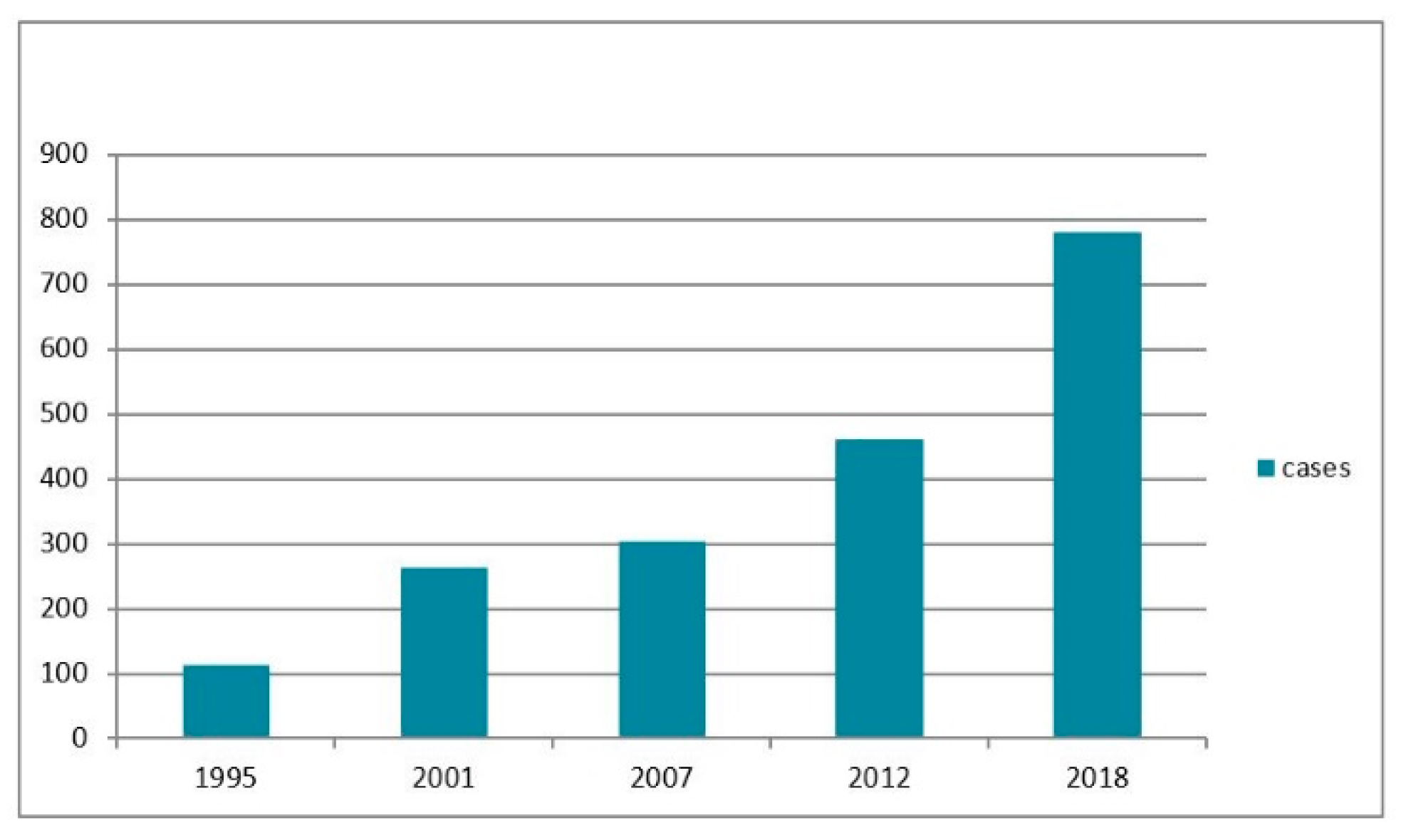
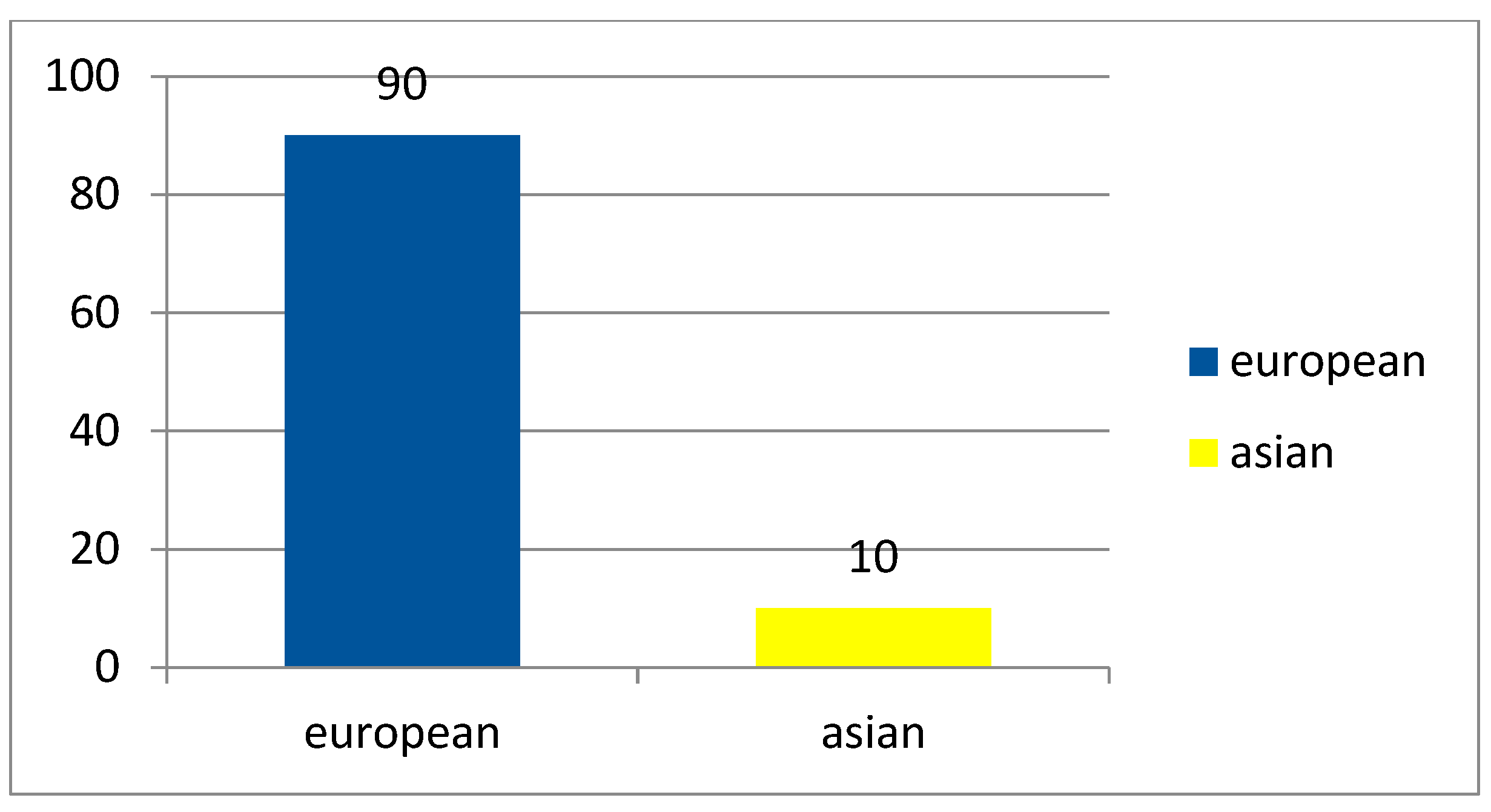
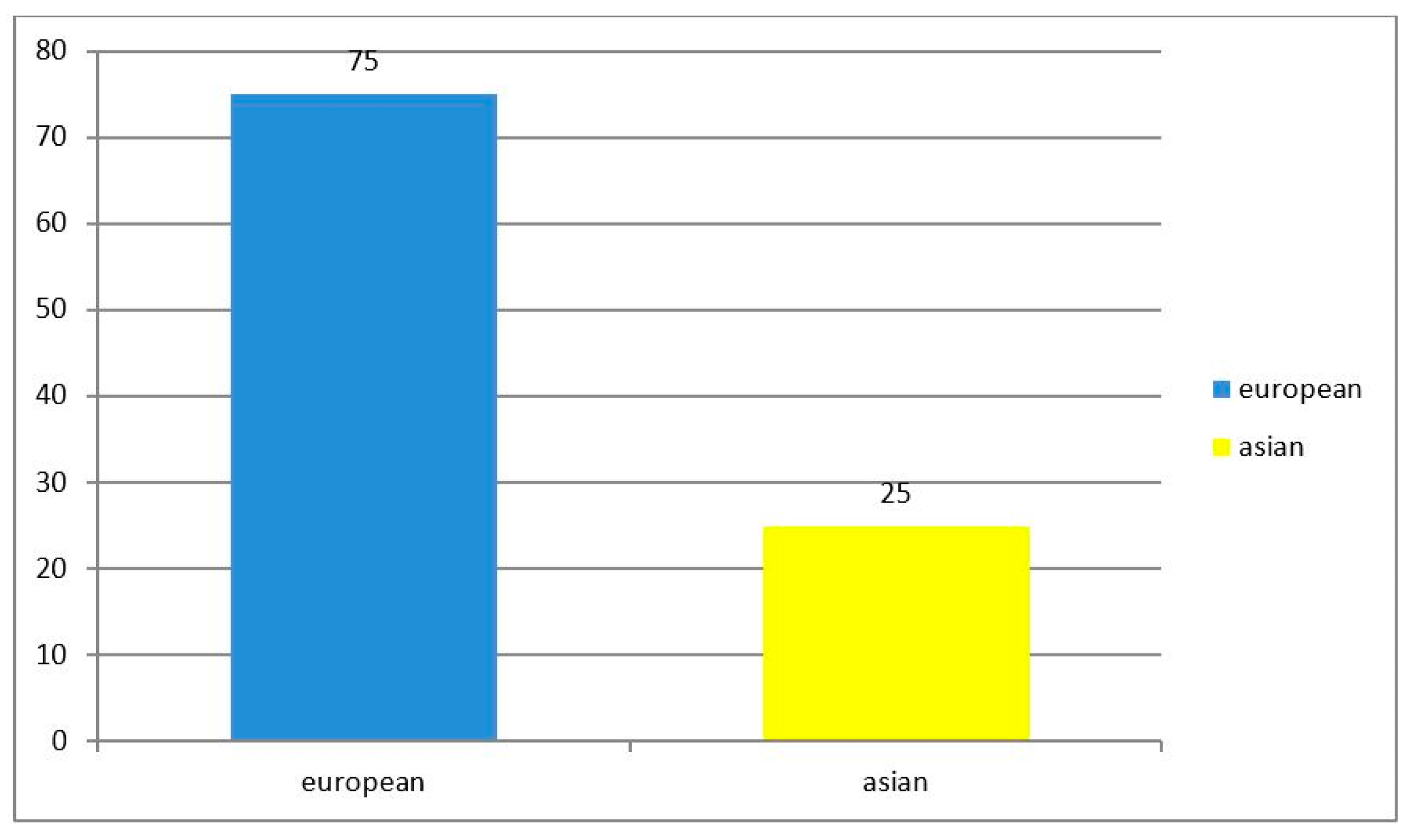
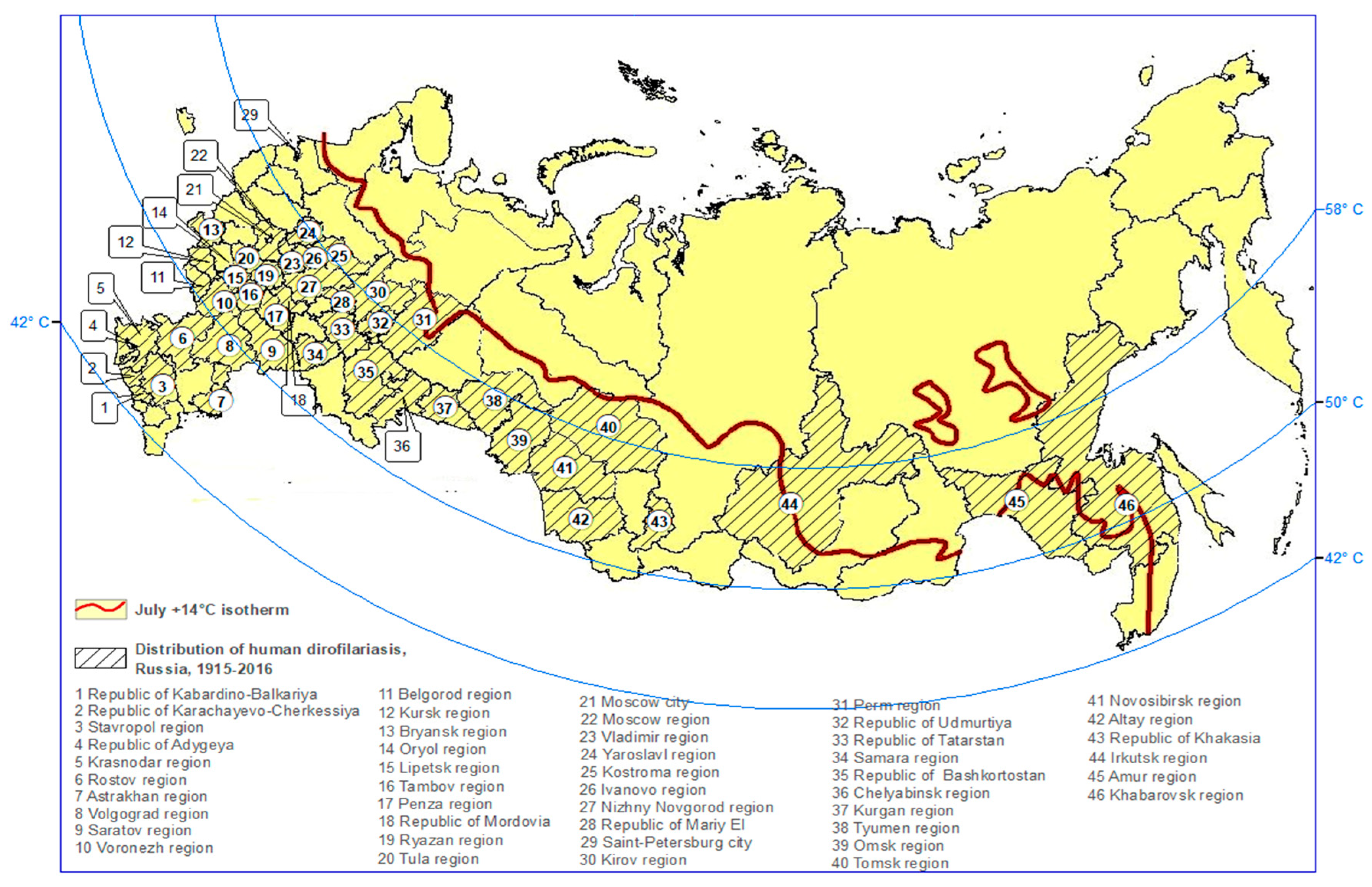
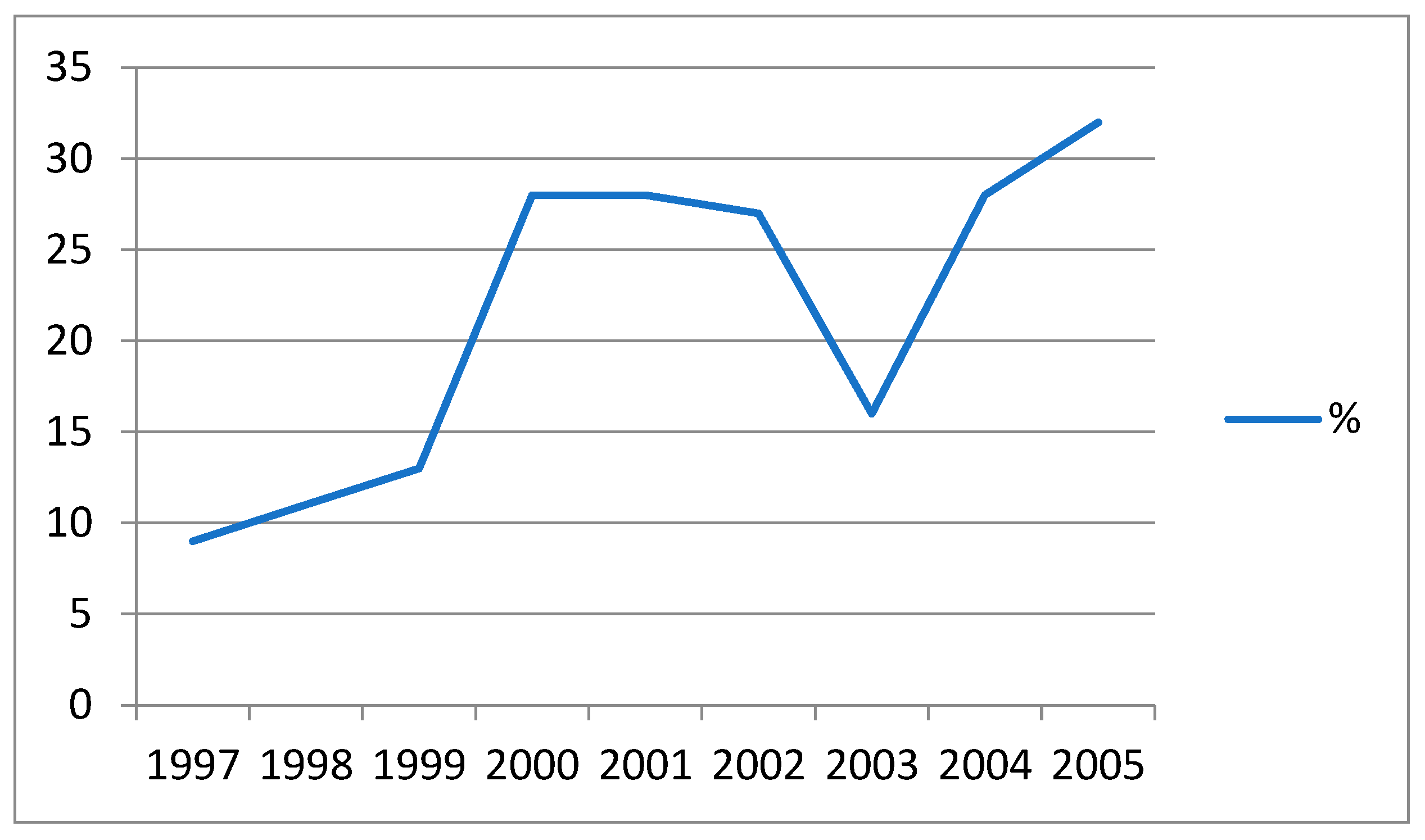
| Year | 1915–1995 * | 1996–2001 | 2002–2007 | 2008–2012 | 2013–2018 |
|---|---|---|---|---|---|
| Cases | 113 | 264 | 303 | 461 | 780 |
| Coordinate | <45° N | 46–50° N | 51–55° N | 56–58° N | >58° N | Total |
|---|---|---|---|---|---|---|
| Administrative territory | 8 | 4 | 22 | 16 | 4 | 54 |
| Season of Clinical Manifestations | Winter | Spring | Summer | Autumn |
|---|---|---|---|---|
| % | 19.2 | 24.8 | 23.0 | 33.0 |
| Year/Area | 2013 | 2014 | 2015 | 2016 | 2017 | 2018 |
|---|---|---|---|---|---|---|
| Moscow city | 28 | 24 | 16 | 11 | 9 | 11 |
| Moscow region (rural) | 2 | 3 | 0 | 0 | 0 | 0 |
| Rest of Russia | 148 | 130 | 103 | 70 | 109 | 89 |
| Year | 2003 | 2004 | 2005 | 2006 | 2007 |
|---|---|---|---|---|---|
| No. of Districts | 19 | 27 | 30 | 32 | 33 |
| Territory | Geographic Position | Rate of Infection (%) | Source |
|---|---|---|---|
| Astrakhan region | 46°34′ | 11.03 | Kovtunov et al., 2008 [29] |
| Rostov region | 47°23′ | 13.6 | Nagorny et al., 2012 [31] |
| Tula region | 54°20′ | 3.5 | Bogacheva et al., 2016 [41] |
| Tomsk region | 56°49′ | 2.3–15.8 | Poltoratzkaya et al., 2018 [26] |
| Tyumen region | 57°15′ | 11.7–17.9 | Darchenkova et al., 2009 [17] |
| Novgorod region | 58°26′ | 11.3 | Rosolovski et al., 2013 [30] |
Publisher’s Note: MDPI stays neutral with regard to jurisdictional claims in published maps and institutional affiliations. |
© 2022 by the authors. Licensee MDPI, Basel, Switzerland. This article is an open access article distributed under the terms and conditions of the Creative Commons Attribution (CC BY) license (https://creativecommons.org/licenses/by/4.0/).
Share and Cite
Kondrashin, A.V.; Morozova, L.F.; Stepanova, E.V.; Turbabina, N.A.; Maksimova, M.S.; Morozov, A.E.; Anikina, A.S.; Morozov, E.N. Global Climate Change and Human Dirofilariasis in Russia. Int. J. Environ. Res. Public Health 2022, 19, 3096. https://doi.org/10.3390/ijerph19053096
Kondrashin AV, Morozova LF, Stepanova EV, Turbabina NA, Maksimova MS, Morozov AE, Anikina AS, Morozov EN. Global Climate Change and Human Dirofilariasis in Russia. International Journal of Environmental Research and Public Health. 2022; 19(5):3096. https://doi.org/10.3390/ijerph19053096
Chicago/Turabian StyleKondrashin, Anatoly V., Lola F. Morozova, Ekaterina V. Stepanova, Natalia A. Turbabina, Maria S. Maksimova, Aleksandr E. Morozov, Alina S. Anikina, and Evgeny N. Morozov. 2022. "Global Climate Change and Human Dirofilariasis in Russia" International Journal of Environmental Research and Public Health 19, no. 5: 3096. https://doi.org/10.3390/ijerph19053096
APA StyleKondrashin, A. V., Morozova, L. F., Stepanova, E. V., Turbabina, N. A., Maksimova, M. S., Morozov, A. E., Anikina, A. S., & Morozov, E. N. (2022). Global Climate Change and Human Dirofilariasis in Russia. International Journal of Environmental Research and Public Health, 19(5), 3096. https://doi.org/10.3390/ijerph19053096






